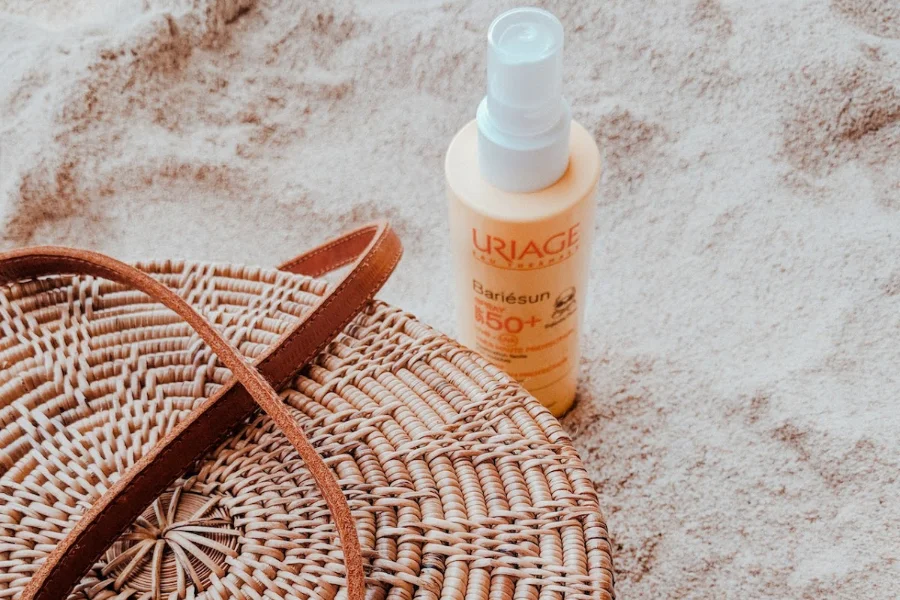The climate emergency and rising pollutants have made sun care an everyday necessity. Due, in part, to social media, consumers are beginning to realize the importance of daily sun care and want to do more to protect their skin from the sun. Learn what the future of sun care looks like and how to create and market products that are effective and accessible for all.
Table of Contents
The sun care market
Sun care around the world
Budget-friendly protection
Hybrid sun care
Snackable sun care solutions
Sun care beyond the face
The future of sun care
The sun care market
The sun care market is booming. Fortune Business Insights predicts the global value of the sun care market will reach USD 16.84 billion by 2027.
Consumer attitudes to sun care have shifted due to more education about sun damage and skin cancer on social media — #SunCare has accumulated 94.5 million views on TikTok. The platform also supports sun safety by banning content that encourages tanning. Global skin cancer rates are expected to increase by 11% by 2050, with the climate emergency and harmful UV rays rising. With the World Meteorological Organization stating heatwaves and record-breaking temperatures “are the new norm,” sun protection is now a necessity and should be accessible to all.
Greater awareness of the sun’s impact on aging has seen suncare and skincare merge. According to the National Library of Medicine in the U.S., 80% of aging in caucasian skin is caused by sun exposure, and consumers who frequently use active skincare ingredients such as retinol and exfoliating acids are more prone to sun sensitivity.
Sun care around the world
Sun care has become a priority globally and is embedded into many people’s regular skincare routines. That being said, regional beauty priorities and differing climates must be accounted for when formulating sun care products to ensure SPFs are comfortable and practical.
According to Statista, sun care is expected to grow at a CAGR of 7% from 2023 to 2027 in the Asia-Pacific. Barrier-protective solutions are trending throughout the region, focusing on protective outdoor solutions and microbiome-boosting ingredients.
In India, attitudes toward sunscreen are shifting due to social media and increased awareness of the impacts of the sun. Rohit Chawl, founder and CEO of Innovist told Cosmetic Design-Asia that sun care is “one of the top searched cosmetic and beauty products these days.”
In Africa, a new wave of indie brands is serving the growing number of beauty consumers. Cape Town-based SKOON describes itself as a natural, sustainable brand using local ingredients. Its SUNNYBONANI day defense sun cream with SPF 20 is a mineral-only-base sunscreen inspired by the African continent. More and more beauty brands are focused on providing specific sun care products for specific skin types and skin tones.
In countries like Canada and the U.S., there can be a vast difference in consumer needs based on widely differing climates. Brands can go beyond SPFs with solutions that help people combat weather and external aggressors specific to their geographical area, including cold weather and wind. Consumers seek products that protect against extreme heat, colder winters, heavier rains, and drought.
After-sun care also presents an area for growth within the sun care beauty market. Soothing and moisture-locking ingredients such as aloe vera and rich antioxidants will help calm and nourish compromised skin.
Budget-friendly protection
The widespread economic crisis and the rising cost of living have increased hygiene poverty. Families on tight incomes are forced to forgo sun protection to buy everyday necessities, putting themselves at risk of future illnesses.
Customer demands for budget-friendly products have evolved. Family-friendly sun care formulations that the entire family can use will be a must, alongside money-saving strategies such as bulk discounts or free shipping.
Some brands have participated in raising awareness about hygiene poverty and donated sun care products to children, such as the #SunPoverty campaign in the UK in 2021.

Hybrid sun care
Serum formats are growing in popularity thanks to their multitasking appeal, comfortable texture, and lightweight application. The more sun care products can be combined with other skin care formulations, the more they appeal to the busy consumer. Conversely, sun care products imbued with skincare benefits will appeal to consistent daily sunscreen users. Modern multifunctional SPF products combine sun protection with beauty benefits such as firming and hydration. Yet, brands are forward-thinking to include other benefits such as protecting against breakouts and blocking dark spots.
As sun protection becomes embedded in skin care and make-up hybrids, ensure formulations are suitable for all skin tones and don’t leave a white cast on darker skin.
Additionally, targeting specific skin issues and conditions can set your formula apart. For example, sun care for acne is a growing opportunity, as traditional formats are often seen as greasy or pore-blocking.

Snackable sun care solutions
Application is one of the most significant barriers to regular sun care usage. Alternative applications and on-the-go sizes will make it easier for people to maintain their sun care habits no matter where they are. As more consumers adopt flexi-lifestyles, portable and easy-to-use sun care will be sought after, from stick solutions to powders and mists.

Sun care beyond the face
As education and awareness grow around sun care, formulas beyond the face will be welcomed in additional beauty categories.
Interest in hand care has become more prominent in the post-pandemic era. The hands are prone to sun damage as an area regularly exposed to UV rays. Suncare for hands should focus on high SPF and water resistance. Additionally, consumers seek products that treat dry hands with soothing ingredients like shea butter, coconut oil, and/or aloe vera.
Hair health has become a critical consumer priority, with protective scalp formulations being essential in hair care. The rise in mist products is impacting the category alongside scalp-specific solutions. Hair mists that nourish and protect the scalp from the sun without weighing down hair will appeal to consumers. In head care, SPF is essential for bald and balding consumers.
With the lines between health and beauty blurring, take a 360-degree approach to sun protection and care.

The future of sun care
Consumers are realizing the importance of regular skin protection; however, sun care may still be tedious or inaccessible. Additionally, even though consumer attitudes have shifted, misinformation and misunderstandings continue about the frequency of application and why it is required all year round, indoors and outdoors.
With SPF considered a basic necessity, it’s important to have affordable and accessible options for everyone. Ensure products come in sizes to suit all budgets, such as family-friendly supersize.
Hybrid products and easy-to-use formats will appeal to the busy consumer. Hybrid products that include SPF as part of daily skincare will be seen as smart, efficient, and cost-effective. And formats such as sticks, powders and mists that offer an easy application for people on the go are a must.





 Afrikaans
Afrikaans አማርኛ
አማርኛ العربية
العربية বাংলা
বাংলা Nederlands
Nederlands English
English Français
Français Deutsch
Deutsch हिन्दी
हिन्दी Bahasa Indonesia
Bahasa Indonesia Italiano
Italiano 日本語
日本語 한국어
한국어 Bahasa Melayu
Bahasa Melayu മലയാളം
മലയാളം پښتو
پښتو فارسی
فارسی Polski
Polski Português
Português Русский
Русский Español
Español Kiswahili
Kiswahili ไทย
ไทย Türkçe
Türkçe اردو
اردو Tiếng Việt
Tiếng Việt isiXhosa
isiXhosa Zulu
Zulu